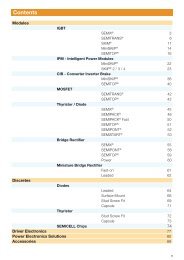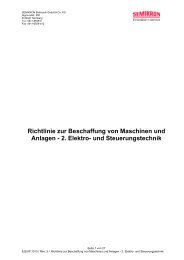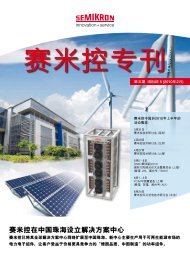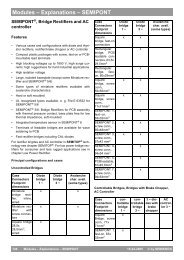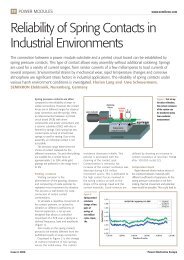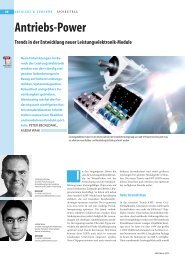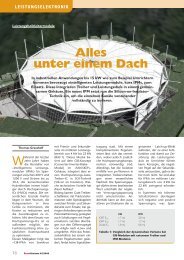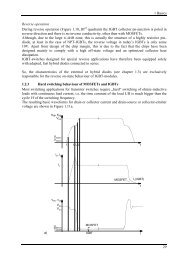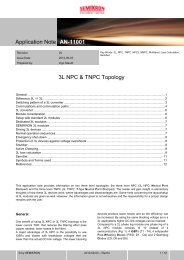Automotive Power Electronics - Future Vehicles Drive Next - Semikron
Automotive Power Electronics - Future Vehicles Drive Next - Semikron
Automotive Power Electronics - Future Vehicles Drive Next - Semikron
Create successful ePaper yourself
Turn your PDF publications into a flip-book with our unique Google optimized e-Paper software.
p34-37 Feature <strong>Semikron</strong> 5/13/05 9:05 Page 34<br />
AUTOMOTIVE POWER ELECTRONICS<br />
<strong>Future</strong> <strong>Vehicles</strong> <strong>Drive</strong> <strong>Next</strong><br />
Generation of <strong>Power</strong> Modules<br />
<strong>Power</strong> electronics plays an increasingly important role in the automotive industry. Hybrid electric drive technology<br />
is now entering the mainstream market with hydrogen powered fuel cell vehicles still in research and<br />
development. One of the clearest indications that the future of vehicle design is changing can be found in the<br />
steady increase in the number of new hybrid models being offered in North America and Europe. This trend is<br />
likely to increase the application of power modules in motor drives. John Mookken, Project Manager, SEMIKRON<br />
Inc., Hudson NH, USA<br />
FRANCAIS<br />
L’électronique de puissance joue un rôle de plus en plus important dans<br />
l’industrie automobile. La technologie d’entraînement à électricité hybride fait<br />
désormais partie du marché de consommation courant tandis que les véhicules<br />
fonctionnant au moyen de piles à combustible à hydrogène sont encore au stade<br />
de la recherche et du développement. Une des plus claires indications que la<br />
conception automobile est en train d’évoluer est l’augmentation constante du<br />
nombre de nouveaux modèles hybrides étant commercialisés en Amérique du<br />
Nord et en Europe. Cette tendance est susceptible d’augmenter l’application des<br />
modules de puissance dans les entraînements de moteur. John<br />
Mookken, Project Manager, SEMIKRON Inc., Hudson NH, USA<br />
Two facts make the importance of<br />
power electronics in future cars<br />
a certainty. The first well-known<br />
fact to consider is that DC motors are<br />
unreliable and less efficient when compared<br />
to AC types. An AC induction<br />
motor has fewer parts, such as brushes<br />
and commutators, which greatly improve<br />
its reliability. AC motors are generally<br />
smaller, less expensive and more efficient<br />
compared to similarly rated DC motors.<br />
It is also known that in the past, the cost<br />
and complexity of AC drives have been<br />
barriers to their acceptance in a number<br />
of applications.<br />
The second fact to consider is that<br />
most hybrid electric vehicles (HEVs)<br />
and most leading drive concepts for<br />
future cars rely on the electric power<br />
being stored in the DC form for a certain<br />
length of time. This means, barring<br />
any major technological breakthroughs<br />
in DC motor design, power must be<br />
converted from one form to another<br />
several times on future cars, and that<br />
virtually guarantees a bright future for<br />
power electronics in the automotive<br />
Figure 1 (right). Split hybrid or full<br />
hybrid (above) a) is the most common<br />
power train concept in current hybrid<br />
cars. In hydrogen powered fuel cell<br />
vehicle concepts (below) b) there are<br />
no internal combustion engines<br />
Die Leistungselektronik spielt eine zunehmend wichtigere Rolle in der<br />
Automobilindustrie. Hybridantriebe gehen nun in den den<br />
Massenmarkt, während mit Wasserstoff betriebene<br />
Brennstoffzellenfahrzeuge noch immer in Forschung und Entwicklug<br />
stecken. Einer der Klarsten Indikatoren für einen Wechsel in der<br />
Automobilentwicklung ist die stetige Zunahme neuer Hybrid-Modelle in<br />
Nordamerika und Europa. Dieser Trend wird die Anwendung von<br />
Leistungsmodulen in Antrieben beschleunigen. John<br />
Mookken, Project Manager, SEMIKRON Inc., Hudson NH,<br />
USA<br />
34 <strong>Power</strong> <strong>Electronics</strong> Europe Issue 4 2005<br />
DEUTSCH
p34-37 Feature <strong>Semikron</strong> 5/13/05 9:05 Page 35<br />
industry. In current HEVs, electrical<br />
energy is generated by the internal<br />
combustion (IC) engine and stored in a<br />
battery pack. This remains true whether<br />
the powertrain design is a parallel, series<br />
or the more common split hybrid design.<br />
In future designs the fuel cell/battery<br />
pack will likely replace the IC engine. In<br />
either case, power must be converted<br />
during charging, braking or coasting<br />
(regeneration), and motoring. <strong>Power</strong><br />
converters and electric motors remain<br />
the common denominator when comparing<br />
different powertrain concepts<br />
illustrated in Figure 1.<br />
AUTOMOTIVE REQUIREMENTS<br />
In today’s industrial applications<br />
dominated $40 billion power electronics<br />
market, modules are not produced<br />
specifically for use in the automotive<br />
industry. Industrial drives components<br />
often cannot meet the reliability requirements<br />
in the harsh automobile operating<br />
environments and military grade components<br />
are too costly for use in cars.<br />
The market is now changing. With more<br />
electrification in future cars and the<br />
transition of the electric motors and<br />
drives from R&D to production vehicles,<br />
power module manufacturers are<br />
recognizing the need to develop power<br />
modules specifically designed to support<br />
the near term and long term needs of<br />
the auto industry. The race has begun<br />
to produce an affordable module that<br />
can meet the demanding performance,<br />
reliability, cost and manufacturability<br />
requirements set forth by the automobile<br />
manufacturers.<br />
In general, some of the key characteristics<br />
for any new power module in<br />
development or in production for<br />
automotive traction applications can be<br />
summarized as follows:<br />
Integration – one can expect to see a<br />
high degree of integration between the<br />
power devices, bus work, heatsink, bus<br />
capacitor, and gate drive/controller to<br />
optimize overall performance. Performance<br />
is measured in terms of output<br />
power, size, weight, cost and manufacturability.<br />
High temperature operation – the<br />
ready source of circulating liquids<br />
found in cars, like radiator coolant and<br />
transmission fluids, make liquid cooling<br />
of the power module on automobiles an<br />
attractive option to improve module<br />
performance. The challenge faced by<br />
power module manufacturers is to<br />
design power modules capable of being<br />
cooled by engine coolant or lubricant<br />
with inlet temperatures of 105ºC. For<br />
power modules this translates to a wider<br />
AUTOMOTIVE POWER ELECTRONICS<br />
Figure 2 Above). The major sub-components that make up a 600 or 1200V IGBT<br />
based SKAI power module (components shown in red can be substituted with<br />
customer furnished parts)<br />
Figure 3 (above). Modular design allows the SKAI module to be easily customised<br />
for specific customers or applications<br />
Issue 4 2005 <strong>Power</strong> <strong>Electronics</strong> Europe 35
p34-37 Feature <strong>Semikron</strong> 5/13/05 9:06 Page 36<br />
AUTOMOTIVE POWER ELECTRONICS<br />
Figure 4 (right).<br />
SKiiP technology in SKAI<br />
operating temperature range (-40 to<br />
125ºC). <strong>Power</strong> devices will require<br />
higher operating junction temperatures<br />
(T j=175ºC), and higher temperature<br />
ratings (150ºC) for packaging and<br />
electronic components.<br />
Flexibility – the term ‘flexibility’ in<br />
this case encompasses the capability for<br />
the module to be scalable, modular and<br />
customizable. The present and near-term<br />
continuous load for automotive traction<br />
applications is between 10kW and<br />
120kW. Just like IC engines in the past,<br />
this figure is expected to rise over time.<br />
Scalability allows the module output<br />
power to be easily scaled up or down<br />
without changing the module footprint.<br />
Modularity allows the design to be<br />
easily upgraded when new technology<br />
becomes available and customizability<br />
makes it easier to integrate customer<br />
furnished materials into the existing<br />
design.<br />
Robustness – high reliability in the<br />
harsh automotive environment is a re-<br />
Table 1 (right).<br />
Complete line of integrated<br />
power modules for automotive<br />
application<br />
quirement for any automotive component.<br />
However, traditionally power<br />
modules have not had to meet the<br />
under-the-hood temperature and vibration<br />
requirements. <strong>Power</strong> modules used<br />
in cars must be designed for the life of a<br />
car, which is usually 100,000 miles<br />
(160,000km) or 15 years. The new power<br />
module designs will have to pass tougher<br />
electrical, mechanical, EMI and environmental<br />
tests.<br />
Economical – one of the key characteristics<br />
of the new power module that<br />
is also in opposition to the other<br />
characteristics listed above is affordability.<br />
A reasonable price target for power<br />
modules in automotive quantities is<br />
estimated to be less than $6/kW for<br />
the design to successfully penetrate the<br />
automotive market.<br />
SKAI ADVANCED INTEGRATION<br />
MODULES<br />
Incorporating most of the desirable<br />
characteristics mentioned in the previ-<br />
ous section into a new first generation<br />
power module for the automotive industry<br />
is SEMIKRON’s SKAI (SEMIKRON<br />
Advanced Integration) module. It integrates<br />
all the necessary hardware for a<br />
drive into a single package and gives us<br />
a glimpse into the future of power<br />
modules.<br />
The module integrates the power stage<br />
with the liquid cooled heatsink, gate<br />
drivers, controller, and protection logic<br />
to provide a ready solution to the automotive<br />
tier 1 suppliers. Figure 2 shows<br />
the key components that make up the<br />
SKAI module.<br />
A high level of integration can be seen<br />
between the AC and DC bus structure<br />
on each of the baseplate less half-bridge<br />
circuits (see Figure 4). Each Direct<br />
Bonded Copper (DBC) AlN ceramic<br />
substrate contains twelve 600V NPT or<br />
1200V trench IGBTs, six matching<br />
diodes and a positive coefficient thermistor<br />
(PTC). The bus structures (AC<br />
and DC) and the populated DBCs are<br />
36 <strong>Power</strong> <strong>Electronics</strong> Europe Issue 4 2005
p34-37 Feature <strong>Semikron</strong> 5/13/05 11:55 Page 37<br />
all held together under more than 153kg/cm 2<br />
of pressure using SEMIKRON’s SKiiP technology,<br />
an unique and proprietary pressure<br />
contact system. Tight integration of the<br />
DC and AC bus bars on the DBC keeps<br />
parasitics to a minimum. Bus filtering is<br />
included with a 1mF metalised polypropylene<br />
capacitor which is also closely integrated with<br />
the bus bars. Two magneto resistive current<br />
sensors are integrated with two of the three<br />
AC bus bars which are attached to the<br />
control board via flexible cables. The control<br />
board interfaces with the DBCs via spring<br />
pins and includes the power supply, gate<br />
drives, DSP, communications hardware<br />
(supports CAN/IEE485) and protection<br />
circuitry.<br />
The SKAI module is designed to operate<br />
in the -40 to 85ºC temperature range. The<br />
module is available on either liquid cooled<br />
or air cooled heat sinks. Coolant inlet<br />
temperatures are limited to 70ºC with higher<br />
temperature operation possible with power<br />
derating.<br />
The modular nature of the SKAI<br />
design allows the units to be easily<br />
customized. Only minimal restrictions are<br />
imposed in cases where the customer wants<br />
to furnish the heatsink which could also be a<br />
part of the customer’s system enclosure or<br />
supply custom control boards with special<br />
connectors or processor.<br />
The SKiiP technology used in the SKAI<br />
module was first introduced by SEMIKRON<br />
in early 1992 in power modules. In addition<br />
to simplifying module assembly, the pressure<br />
system eliminates the large solder interfaces<br />
typically seen between the DBC and the<br />
module baseplate which greatly improves<br />
reliability. The pressure system is shown to be<br />
superior to traditional power modules by a<br />
factor of 10 in power cycling tests. The use<br />
of AlN substrate also improves reliability;<br />
studies have shown that the module<br />
lifetime can improved by a factor of 2 using<br />
AlN rather than the less expensive Alumina<br />
(Al 2O 3). The pressure system also reduces<br />
the number of wire bonds in the power<br />
module by using spring pins to contact the<br />
gate and sensor connections from the DBCs<br />
to the driver/control board. The use of<br />
Ag plated spring pins have been shown to<br />
be a highly reliable method for low current<br />
control and sensor contacts for use in power<br />
modules.<br />
In addition to automotive applications<br />
in hydrogen powered fuel cell vehicles,<br />
SKAI modules are currently undergoing<br />
field tests in applications as varied as<br />
driving radiator fans and providing<br />
auxiliary power on railroad locomotives<br />
and agriculture vehicles, traction and<br />
hydraulic pump motor drive on mining<br />
vehicles and as traction drives on small<br />
electric vehicles.<br />
FUTURE DEVELOPMENTS<br />
The second generation of the SKAI<br />
module, which is under development, will<br />
feature a wider operating and storage<br />
temperature range. A more advanced<br />
heatsink design has the potential to significantly<br />
improve power density of the existing<br />
SKAI module. Higher junction temperature<br />
Si trench IGBTs, high temperature conductive<br />
plastics or light weight metal enclosures,<br />
new current sensor technologies and high<br />
temperature capacitors are being developed<br />
AUTOMOTIVE POWER ELECTRONICS<br />
for FREE information enter 19<br />
for the next generation. The new SKAI will<br />
include a more capable controller such as<br />
the TI 28xx series DSPs and triple sealed<br />
automotive style connectors with more I/O<br />
lines. The lure of high volumes in future<br />
cars will continue to drive the power<br />
module manufacturers to push the envelope<br />
of performance and affordability of future<br />
power modules. www.semikron.com<br />
Enquiry No: 253<br />
Issue 4 2005 <strong>Power</strong> <strong>Electronics</strong> Europe 37



